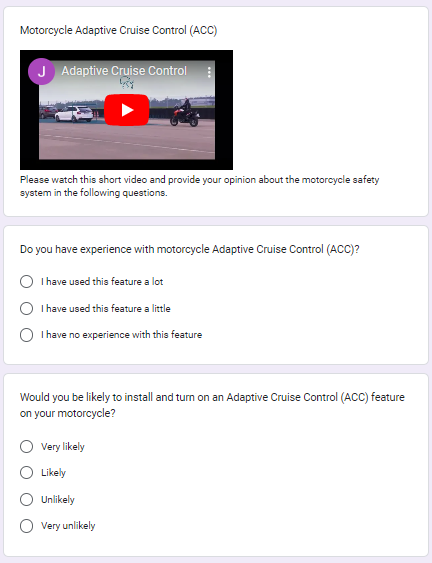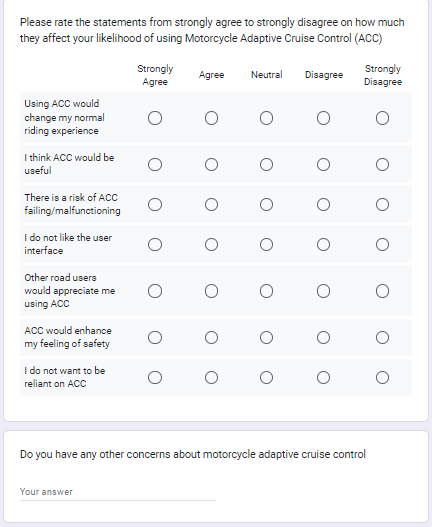
Jordan Martin
Psychology BSc (first class honours) at Northumbria University

Psychology BSc (first class honours) at Northumbria University

What are Motorcyclists’ Attitudes Towards Motorcycle Autonomous Rider Assistance Systems (ARAS)?
ARAS are designed to improve motorcycle safety and performance by using technologies like sensors and cameras to monitor riding conditions and provide autonomous assistance. Previous research has provided some support that ARAS may positively influence motorcycle crash outcomes. However, there has been little research conducted investigating motorcycle riders’ attitudes towards ARAS. The acceptability of these features is necessary if they are to be purchased, installed and used in order to improve rider safety. This project aimed to investigate riders’ usage intentions towards five ARAS and identify the key factors influencing riders usage intentions.



Methods
The study looked at five features, three of which are currently available for motorcycles: adaptive cruise control (ACC), forward collision warning (FCW) and blind-spot detection (BSD). As well as two systems that are currently available in cars, and are in development for motorcycles: autonomous emergency braking (AEB) and autonomous steering assist (ESA).
A mixed methods online questionnaire was used. Demographic information was collected, including years of riding experience and frequency of riding. (n = 229) Participants were shown demonstration videos of each feature, rated their level of experience with the feature and their likelihood to install and turn on the feature. Participants rated statements on how much they affected their usage intentions concerning: perceived usefulness, the risk of system failure, the appraisal of the user interface, perceived social norm, feeling of safety, and reliance on the feature. Participants gave open-ended responses about their concerns with each feature.
Participants’ riding duration ranged from 1 year to 54 years (M = 20.53, SD = 13.39). The typical participant rides their motorcycle a few times a week.
Quantitative results



Thematic analysis
The primary theme that emerged was “concerns about safety and reliability”. This theme encompassed the majority of responses and included codes of lack of trust in the safety of ARAS, interference with riders’ emergency swerving responses, the risk of system failure and malfunction, the danger of system activation during certain manoeuvres, the vulnerability of motorcycle riders, and the negative effect ARAS may have on riding ability.
The second theme: “Impact on rider experience and rider autonomy” related to riders desire for personal control, beliefs that ARAS reduce riding enjoyment, and are too invasive.
The third theme: “Conditions for installation” included concerns about the cost of ARAS, the importance of being able to turn the feature off when needed, and the specific conditions in which riders may use certain features e.g. ACC was perceived to be useful for commuter riders. Riders expressed a preference for pre-installed ARAS due to concerns of cost and reliability.
Conclusions and implications
